Principles of Language Learning: Cross-Cultural Issues and Strategies
VerifiedAdded on 2022/09/14
|12
|2931
|14
Homework Assignment
AI Summary
This assignment delves into various aspects of second language (L2) learning and teaching. It begins by examining constructivist views and the importance of understanding learners' needs and cultural contexts. The assignment then explores student engagement, particularly the role of group dynamism in the classroom, and the challenges of social distancing in cross-cultural groups. It addresses how teachers can bridge cultural gaps through specific activities and syllabus design, incorporating notional concepts and cultural elements. The assignment further discusses developing communicative competence, emphasizing the seven functions of language and the use of notional functional syllabuses. It also covers interpersonal and intercommunity communication interfaces, the importance of distinguishing between language and communication competencies, and the avoidance of overcorrection. The assignment concludes with personal reflections on language learning experiences, the use of visuals, prefabricated phrases, and learner-centered curricula. It also analyzes the effectiveness of storytelling and dictation techniques in language acquisition, referencing video resources to illustrate key concepts.

Paraphrase This Document
Need a fresh take? Get an instant paraphrase of this document with our AI Paraphraser

Question 1
A constructivist view towards the need of the learners is the most important virtue that can define
the relationship between a learner and the teacher while pursuing a course of language learning.
This constructivist view of the teacher allows him to understand the requirements and gaps of
information that need to be filled while imparting education. A constructivist view over the class
can allow a teacher to maintain the records of every student as a separate case study. The
monitoring of these case records can help him in developing strategies for each student on an
interpersonal level (Brown, 2014).
The study of the cultural context of each student is very important because every language is an
outcome of various types of cultures. A constructivist view allows a teacher to understand the
gaps caused by the variance in the culture as well. Sometimes an affinity in the cultures can
increase or decrease the complexity levels in the learning processes. This compatibility or
incompatibility can sometimes become a decisive factor in the performance of a student .
Question 2
I agree with the views of Zoltan Dornyei, especially when he mentions the group dynamism as a
factor of engagement for the students. I agree with the fact that the presence of individuals
belonging to various cultures in a single classroom creates a positive dynamism among the
group. This type of arrangement removes the peer pressure from the student because all of them
face the same set of problems. For a definitive solution, a constructivist view is required where a
teacher has to figure out unique ways to address the problems of various students (Dornyei,
2018).
A constructivist view towards the need of the learners is the most important virtue that can define
the relationship between a learner and the teacher while pursuing a course of language learning.
This constructivist view of the teacher allows him to understand the requirements and gaps of
information that need to be filled while imparting education. A constructivist view over the class
can allow a teacher to maintain the records of every student as a separate case study. The
monitoring of these case records can help him in developing strategies for each student on an
interpersonal level (Brown, 2014).
The study of the cultural context of each student is very important because every language is an
outcome of various types of cultures. A constructivist view allows a teacher to understand the
gaps caused by the variance in the culture as well. Sometimes an affinity in the cultures can
increase or decrease the complexity levels in the learning processes. This compatibility or
incompatibility can sometimes become a decisive factor in the performance of a student .
Question 2
I agree with the views of Zoltan Dornyei, especially when he mentions the group dynamism as a
factor of engagement for the students. I agree with the fact that the presence of individuals
belonging to various cultures in a single classroom creates a positive dynamism among the
group. This type of arrangement removes the peer pressure from the student because all of them
face the same set of problems. For a definitive solution, a constructivist view is required where a
teacher has to figure out unique ways to address the problems of various students (Dornyei,
2018).
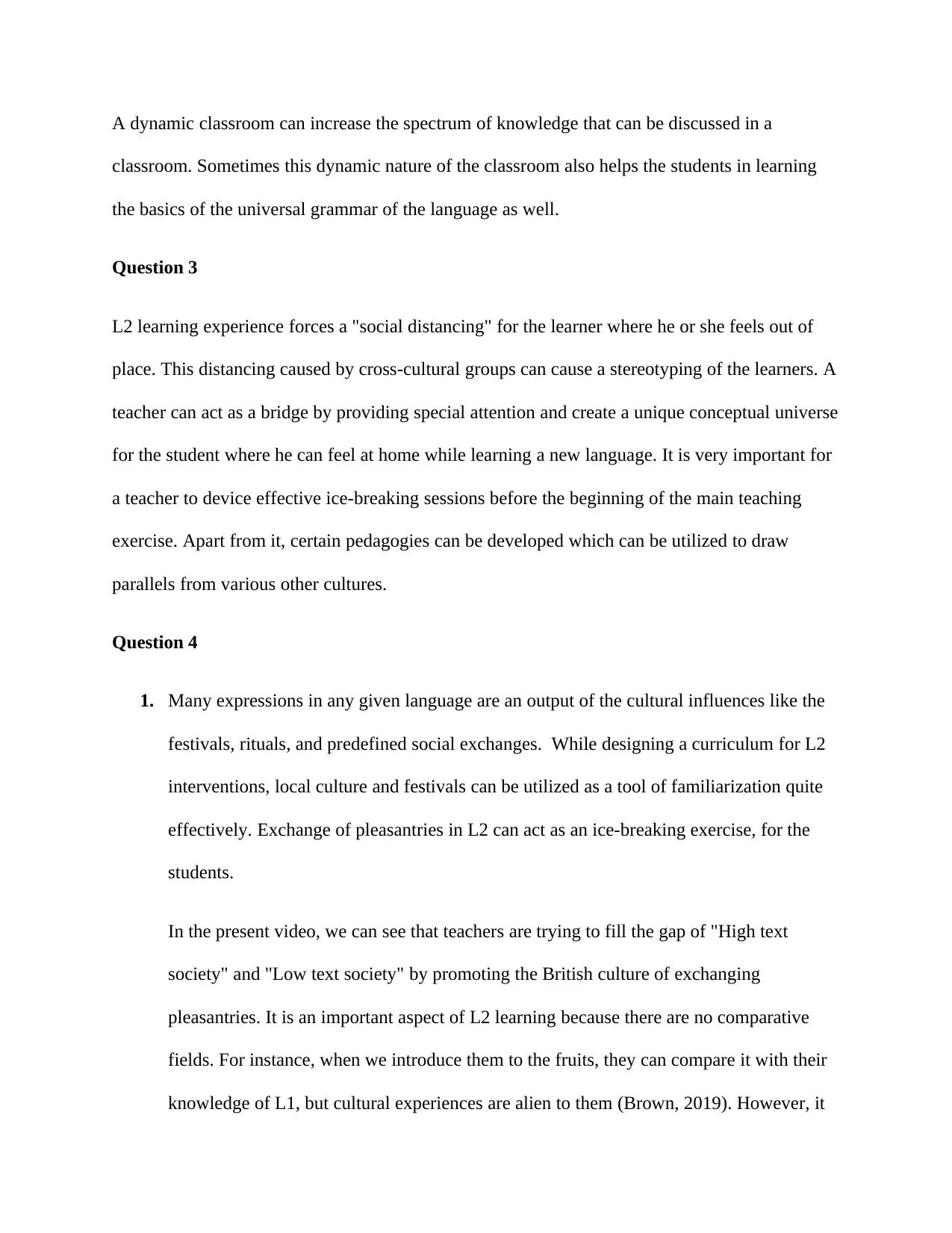
A dynamic classroom can increase the spectrum of knowledge that can be discussed in a
classroom. Sometimes this dynamic nature of the classroom also helps the students in learning
the basics of the universal grammar of the language as well.
Question 3
L2 learning experience forces a "social distancing" for the learner where he or she feels out of
place. This distancing caused by cross-cultural groups can cause a stereotyping of the learners. A
teacher can act as a bridge by providing special attention and create a unique conceptual universe
for the student where he can feel at home while learning a new language. It is very important for
a teacher to device effective ice-breaking sessions before the beginning of the main teaching
exercise. Apart from it, certain pedagogies can be developed which can be utilized to draw
parallels from various other cultures.
Question 4
1. Many expressions in any given language are an output of the cultural influences like the
festivals, rituals, and predefined social exchanges. While designing a curriculum for L2
interventions, local culture and festivals can be utilized as a tool of familiarization quite
effectively. Exchange of pleasantries in L2 can act as an ice-breaking exercise, for the
students.
In the present video, we can see that teachers are trying to fill the gap of "High text
society" and "Low text society" by promoting the British culture of exchanging
pleasantries. It is an important aspect of L2 learning because there are no comparative
fields. For instance, when we introduce them to the fruits, they can compare it with their
knowledge of L1, but cultural experiences are alien to them (Brown, 2019). However, it
classroom. Sometimes this dynamic nature of the classroom also helps the students in learning
the basics of the universal grammar of the language as well.
Question 3
L2 learning experience forces a "social distancing" for the learner where he or she feels out of
place. This distancing caused by cross-cultural groups can cause a stereotyping of the learners. A
teacher can act as a bridge by providing special attention and create a unique conceptual universe
for the student where he can feel at home while learning a new language. It is very important for
a teacher to device effective ice-breaking sessions before the beginning of the main teaching
exercise. Apart from it, certain pedagogies can be developed which can be utilized to draw
parallels from various other cultures.
Question 4
1. Many expressions in any given language are an output of the cultural influences like the
festivals, rituals, and predefined social exchanges. While designing a curriculum for L2
interventions, local culture and festivals can be utilized as a tool of familiarization quite
effectively. Exchange of pleasantries in L2 can act as an ice-breaking exercise, for the
students.
In the present video, we can see that teachers are trying to fill the gap of "High text
society" and "Low text society" by promoting the British culture of exchanging
pleasantries. It is an important aspect of L2 learning because there are no comparative
fields. For instance, when we introduce them to the fruits, they can compare it with their
knowledge of L1, but cultural experiences are alien to them (Brown, 2019). However, it
⊘ This is a preview!⊘
Do you want full access?
Subscribe today to unlock all pages.

Trusted by 1+ million students worldwide
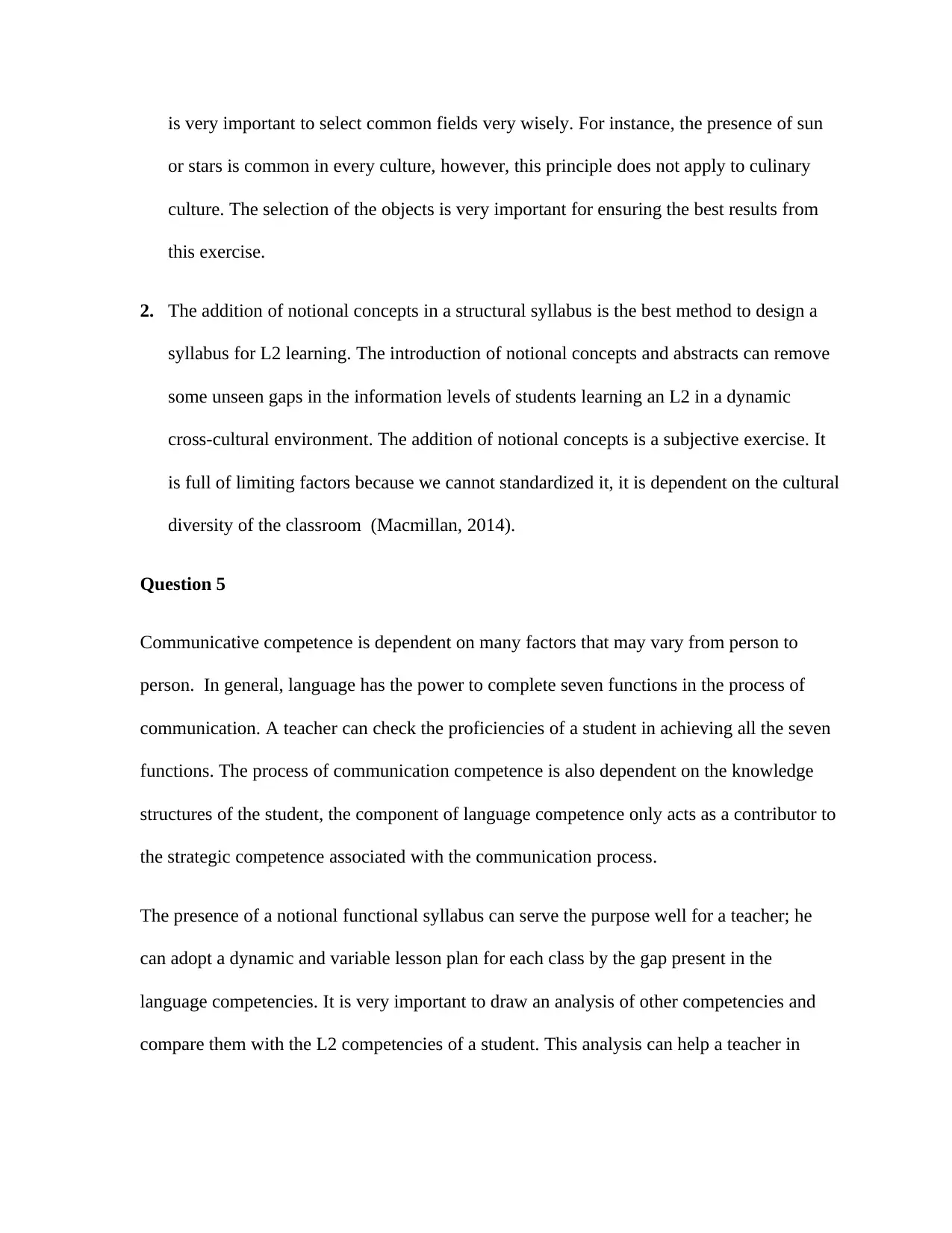
is very important to select common fields very wisely. For instance, the presence of sun
or stars is common in every culture, however, this principle does not apply to culinary
culture. The selection of the objects is very important for ensuring the best results from
this exercise.
2. The addition of notional concepts in a structural syllabus is the best method to design a
syllabus for L2 learning. The introduction of notional concepts and abstracts can remove
some unseen gaps in the information levels of students learning an L2 in a dynamic
cross-cultural environment. The addition of notional concepts is a subjective exercise. It
is full of limiting factors because we cannot standardized it, it is dependent on the cultural
diversity of the classroom (Macmillan, 2014).
Question 5
Communicative competence is dependent on many factors that may vary from person to
person. In general, language has the power to complete seven functions in the process of
communication. A teacher can check the proficiencies of a student in achieving all the seven
functions. The process of communication competence is also dependent on the knowledge
structures of the student, the component of language competence only acts as a contributor to
the strategic competence associated with the communication process.
The presence of a notional functional syllabus can serve the purpose well for a teacher; he
can adopt a dynamic and variable lesson plan for each class by the gap present in the
language competencies. It is very important to draw an analysis of other competencies and
compare them with the L2 competencies of a student. This analysis can help a teacher in
or stars is common in every culture, however, this principle does not apply to culinary
culture. The selection of the objects is very important for ensuring the best results from
this exercise.
2. The addition of notional concepts in a structural syllabus is the best method to design a
syllabus for L2 learning. The introduction of notional concepts and abstracts can remove
some unseen gaps in the information levels of students learning an L2 in a dynamic
cross-cultural environment. The addition of notional concepts is a subjective exercise. It
is full of limiting factors because we cannot standardized it, it is dependent on the cultural
diversity of the classroom (Macmillan, 2014).
Question 5
Communicative competence is dependent on many factors that may vary from person to
person. In general, language has the power to complete seven functions in the process of
communication. A teacher can check the proficiencies of a student in achieving all the seven
functions. The process of communication competence is also dependent on the knowledge
structures of the student, the component of language competence only acts as a contributor to
the strategic competence associated with the communication process.
The presence of a notional functional syllabus can serve the purpose well for a teacher; he
can adopt a dynamic and variable lesson plan for each class by the gap present in the
language competencies. It is very important to draw an analysis of other competencies and
compare them with the L2 competencies of a student. This analysis can help a teacher in
Paraphrase This Document
Need a fresh take? Get an instant paraphrase of this document with our AI Paraphraser
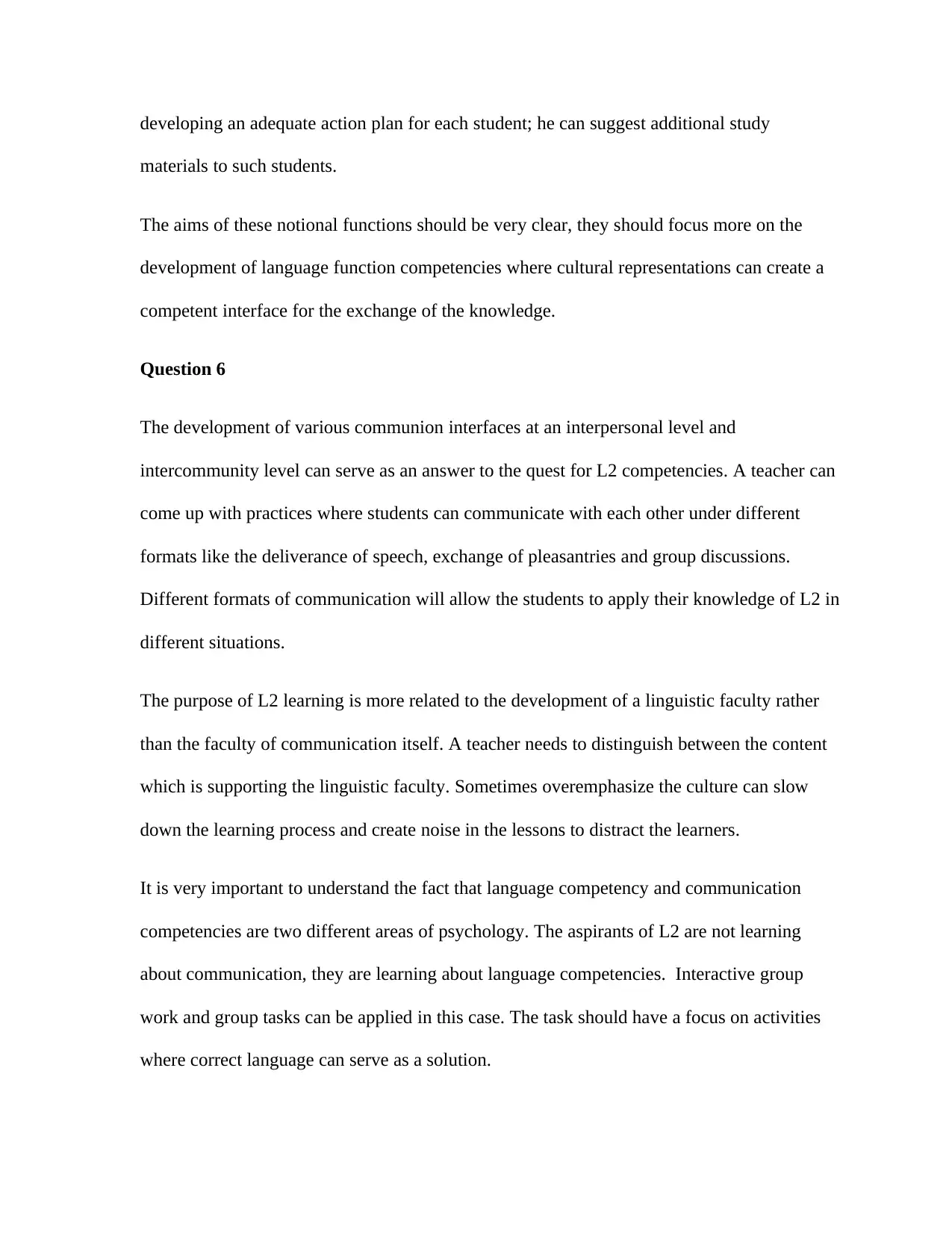
developing an adequate action plan for each student; he can suggest additional study
materials to such students.
The aims of these notional functions should be very clear, they should focus more on the
development of language function competencies where cultural representations can create a
competent interface for the exchange of the knowledge.
Question 6
The development of various communion interfaces at an interpersonal level and
intercommunity level can serve as an answer to the quest for L2 competencies. A teacher can
come up with practices where students can communicate with each other under different
formats like the deliverance of speech, exchange of pleasantries and group discussions.
Different formats of communication will allow the students to apply their knowledge of L2 in
different situations.
The purpose of L2 learning is more related to the development of a linguistic faculty rather
than the faculty of communication itself. A teacher needs to distinguish between the content
which is supporting the linguistic faculty. Sometimes overemphasize the culture can slow
down the learning process and create noise in the lessons to distract the learners.
It is very important to understand the fact that language competency and communication
competencies are two different areas of psychology. The aspirants of L2 are not learning
about communication, they are learning about language competencies. Interactive group
work and group tasks can be applied in this case. The task should have a focus on activities
where correct language can serve as a solution.
materials to such students.
The aims of these notional functions should be very clear, they should focus more on the
development of language function competencies where cultural representations can create a
competent interface for the exchange of the knowledge.
Question 6
The development of various communion interfaces at an interpersonal level and
intercommunity level can serve as an answer to the quest for L2 competencies. A teacher can
come up with practices where students can communicate with each other under different
formats like the deliverance of speech, exchange of pleasantries and group discussions.
Different formats of communication will allow the students to apply their knowledge of L2 in
different situations.
The purpose of L2 learning is more related to the development of a linguistic faculty rather
than the faculty of communication itself. A teacher needs to distinguish between the content
which is supporting the linguistic faculty. Sometimes overemphasize the culture can slow
down the learning process and create noise in the lessons to distract the learners.
It is very important to understand the fact that language competency and communication
competencies are two different areas of psychology. The aspirants of L2 are not learning
about communication, they are learning about language competencies. Interactive group
work and group tasks can be applied in this case. The task should have a focus on activities
where correct language can serve as a solution.

As a teacher an individual must go for two types of analysis, they should go for the exercise
of conversation analysis and discourse analysis. Both these analysis acts as a medium to
judge different types of communication competencies. Under this arrangement, a teacher can
monitor the growth of an L2 student and come up with "check and balance" interventions.
Question 7
The phenomenon of overcorrection occurs when a teacher fails in identifying the difference
between an error and a mistake. Committing mistakes while speaking L2 reflects that the
learners are suffering from an idiosyncrasy caused by a variance in the language. Sometimes
mistakes take place when they adopt universal grammar and oversight the grammar of the
L2. It is very important to understand the concept of universal grammar and subtle variations
in the translation of the language. When we talk about errors, we refer to grammatical errors
such as the use of the tenses, verbs, and adjectives.
Ideally, the limits of the correction should remain confined to the errors rather than the
mistakes. A correction becomes an overcorrection when a teacher tries to intimidate the
natural style of the communication of the student. It is important to distinguish between
communication competencies and language competencies. A teacher should restrict his
corrections to language competencies only. He should focus more on grammatical errors, he
can suggest certain advance uses of the language, however, it is additional knowledge, and
sometimes it can restrict the flow of the natural evolution of the language in a student. The
best correction made by a teacher should be aimed at the development of a language
equivalent from L1 to L2.
Question 8
of conversation analysis and discourse analysis. Both these analysis acts as a medium to
judge different types of communication competencies. Under this arrangement, a teacher can
monitor the growth of an L2 student and come up with "check and balance" interventions.
Question 7
The phenomenon of overcorrection occurs when a teacher fails in identifying the difference
between an error and a mistake. Committing mistakes while speaking L2 reflects that the
learners are suffering from an idiosyncrasy caused by a variance in the language. Sometimes
mistakes take place when they adopt universal grammar and oversight the grammar of the
L2. It is very important to understand the concept of universal grammar and subtle variations
in the translation of the language. When we talk about errors, we refer to grammatical errors
such as the use of the tenses, verbs, and adjectives.
Ideally, the limits of the correction should remain confined to the errors rather than the
mistakes. A correction becomes an overcorrection when a teacher tries to intimidate the
natural style of the communication of the student. It is important to distinguish between
communication competencies and language competencies. A teacher should restrict his
corrections to language competencies only. He should focus more on grammatical errors, he
can suggest certain advance uses of the language, however, it is additional knowledge, and
sometimes it can restrict the flow of the natural evolution of the language in a student. The
best correction made by a teacher should be aimed at the development of a language
equivalent from L1 to L2.
Question 8
⊘ This is a preview!⊘
Do you want full access?
Subscribe today to unlock all pages.

Trusted by 1+ million students worldwide
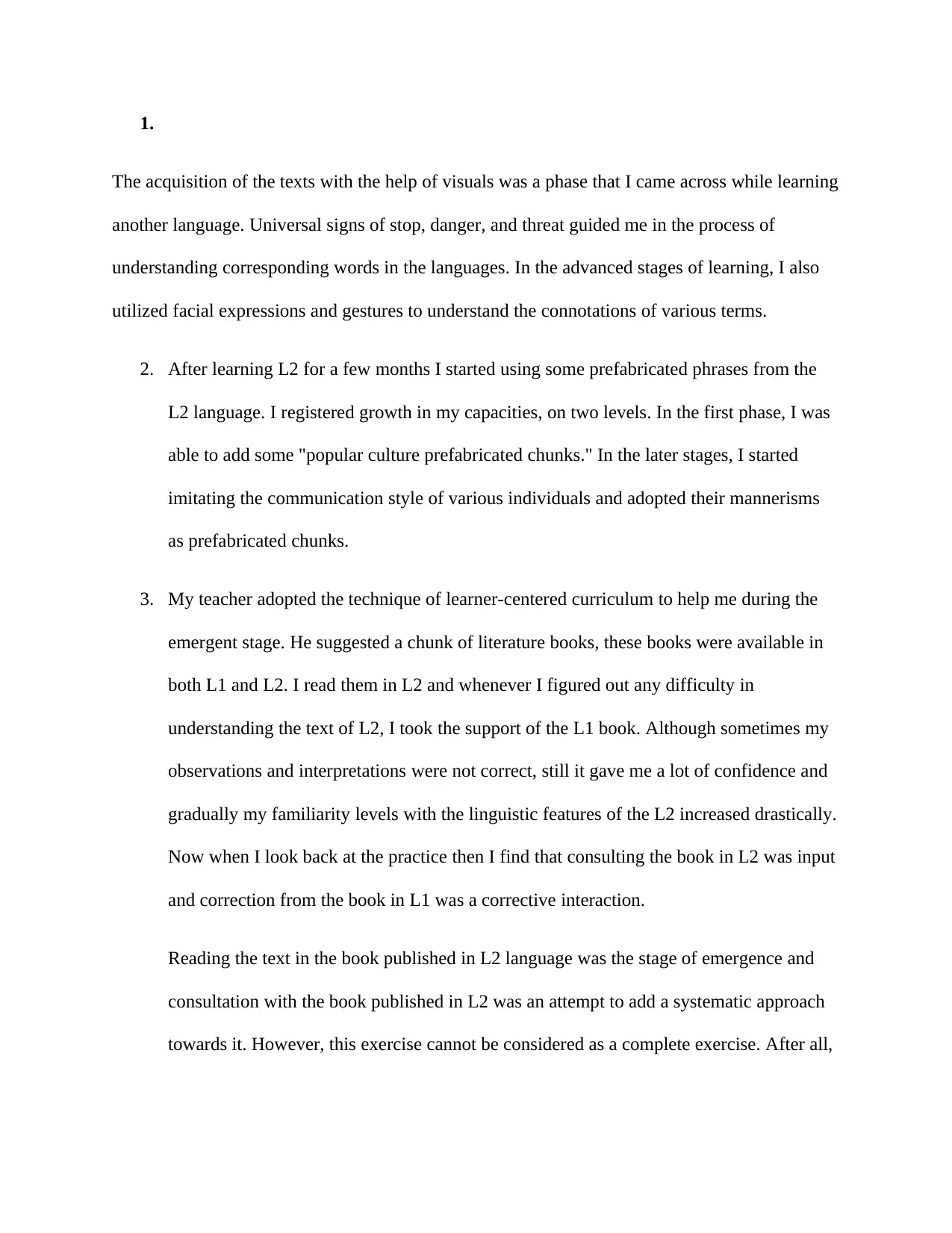
1.
The acquisition of the texts with the help of visuals was a phase that I came across while learning
another language. Universal signs of stop, danger, and threat guided me in the process of
understanding corresponding words in the languages. In the advanced stages of learning, I also
utilized facial expressions and gestures to understand the connotations of various terms.
2. After learning L2 for a few months I started using some prefabricated phrases from the
L2 language. I registered growth in my capacities, on two levels. In the first phase, I was
able to add some "popular culture prefabricated chunks." In the later stages, I started
imitating the communication style of various individuals and adopted their mannerisms
as prefabricated chunks.
3. My teacher adopted the technique of learner-centered curriculum to help me during the
emergent stage. He suggested a chunk of literature books, these books were available in
both L1 and L2. I read them in L2 and whenever I figured out any difficulty in
understanding the text of L2, I took the support of the L1 book. Although sometimes my
observations and interpretations were not correct, still it gave me a lot of confidence and
gradually my familiarity levels with the linguistic features of the L2 increased drastically.
Now when I look back at the practice then I find that consulting the book in L2 was input
and correction from the book in L1 was a corrective interaction.
Reading the text in the book published in L2 language was the stage of emergence and
consultation with the book published in L2 was an attempt to add a systematic approach
towards it. However, this exercise cannot be considered as a complete exercise. After all,
The acquisition of the texts with the help of visuals was a phase that I came across while learning
another language. Universal signs of stop, danger, and threat guided me in the process of
understanding corresponding words in the languages. In the advanced stages of learning, I also
utilized facial expressions and gestures to understand the connotations of various terms.
2. After learning L2 for a few months I started using some prefabricated phrases from the
L2 language. I registered growth in my capacities, on two levels. In the first phase, I was
able to add some "popular culture prefabricated chunks." In the later stages, I started
imitating the communication style of various individuals and adopted their mannerisms
as prefabricated chunks.
3. My teacher adopted the technique of learner-centered curriculum to help me during the
emergent stage. He suggested a chunk of literature books, these books were available in
both L1 and L2. I read them in L2 and whenever I figured out any difficulty in
understanding the text of L2, I took the support of the L1 book. Although sometimes my
observations and interpretations were not correct, still it gave me a lot of confidence and
gradually my familiarity levels with the linguistic features of the L2 increased drastically.
Now when I look back at the practice then I find that consulting the book in L2 was input
and correction from the book in L1 was a corrective interaction.
Reading the text in the book published in L2 language was the stage of emergence and
consultation with the book published in L2 was an attempt to add a systematic approach
towards it. However, this exercise cannot be considered as a complete exercise. After all,
Paraphrase This Document
Need a fresh take? Get an instant paraphrase of this document with our AI Paraphraser
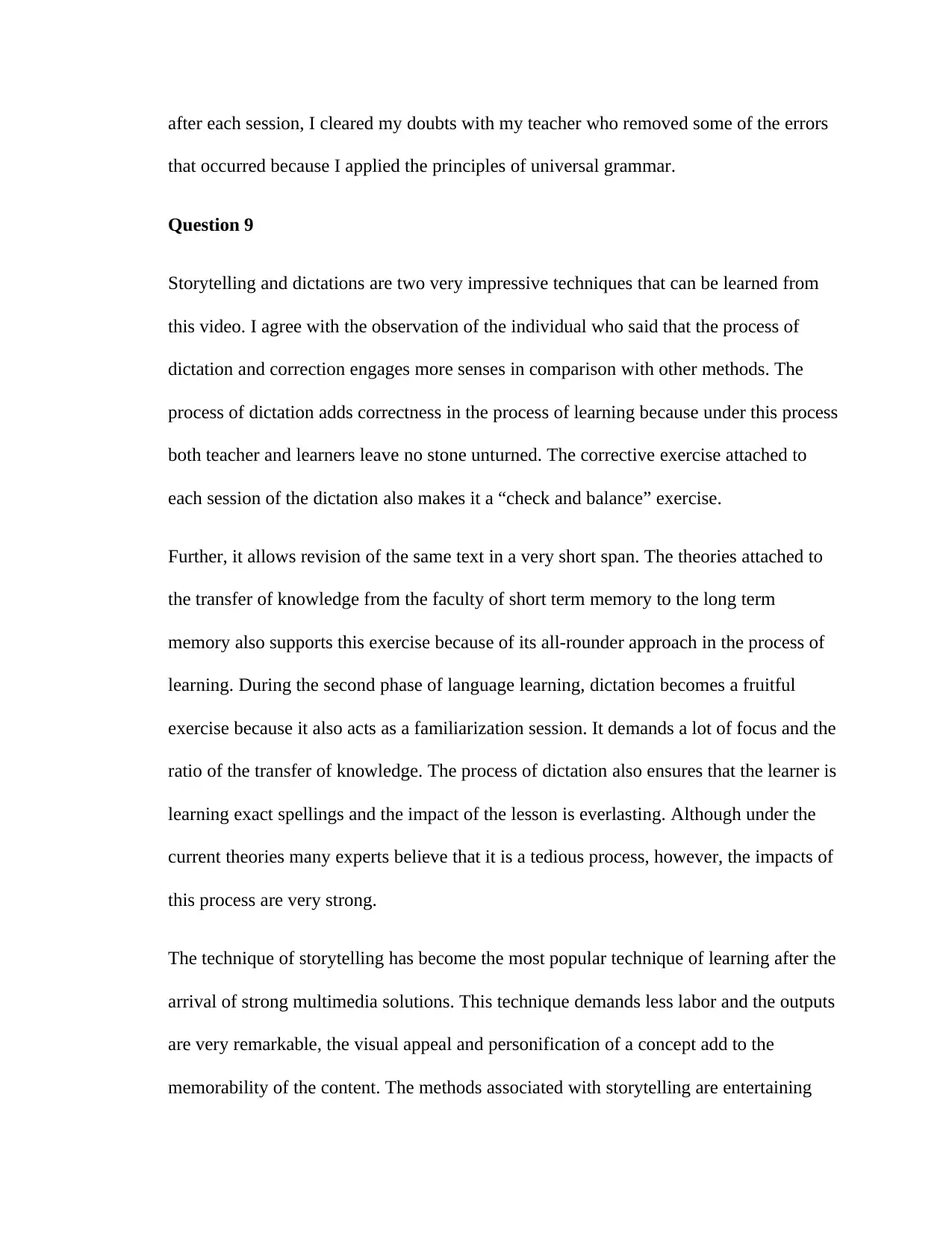
after each session, I cleared my doubts with my teacher who removed some of the errors
that occurred because I applied the principles of universal grammar.
Question 9
Storytelling and dictations are two very impressive techniques that can be learned from
this video. I agree with the observation of the individual who said that the process of
dictation and correction engages more senses in comparison with other methods. The
process of dictation adds correctness in the process of learning because under this process
both teacher and learners leave no stone unturned. The corrective exercise attached to
each session of the dictation also makes it a “check and balance” exercise.
Further, it allows revision of the same text in a very short span. The theories attached to
the transfer of knowledge from the faculty of short term memory to the long term
memory also supports this exercise because of its all-rounder approach in the process of
learning. During the second phase of language learning, dictation becomes a fruitful
exercise because it also acts as a familiarization session. It demands a lot of focus and the
ratio of the transfer of knowledge. The process of dictation also ensures that the learner is
learning exact spellings and the impact of the lesson is everlasting. Although under the
current theories many experts believe that it is a tedious process, however, the impacts of
this process are very strong.
The technique of storytelling has become the most popular technique of learning after the
arrival of strong multimedia solutions. This technique demands less labor and the outputs
are very remarkable, the visual appeal and personification of a concept add to the
memorability of the content. The methods associated with storytelling are entertaining
that occurred because I applied the principles of universal grammar.
Question 9
Storytelling and dictations are two very impressive techniques that can be learned from
this video. I agree with the observation of the individual who said that the process of
dictation and correction engages more senses in comparison with other methods. The
process of dictation adds correctness in the process of learning because under this process
both teacher and learners leave no stone unturned. The corrective exercise attached to
each session of the dictation also makes it a “check and balance” exercise.
Further, it allows revision of the same text in a very short span. The theories attached to
the transfer of knowledge from the faculty of short term memory to the long term
memory also supports this exercise because of its all-rounder approach in the process of
learning. During the second phase of language learning, dictation becomes a fruitful
exercise because it also acts as a familiarization session. It demands a lot of focus and the
ratio of the transfer of knowledge. The process of dictation also ensures that the learner is
learning exact spellings and the impact of the lesson is everlasting. Although under the
current theories many experts believe that it is a tedious process, however, the impacts of
this process are very strong.
The technique of storytelling has become the most popular technique of learning after the
arrival of strong multimedia solutions. This technique demands less labor and the outputs
are very remarkable, the visual appeal and personification of a concept add to the
memorability of the content. The methods associated with storytelling are entertaining
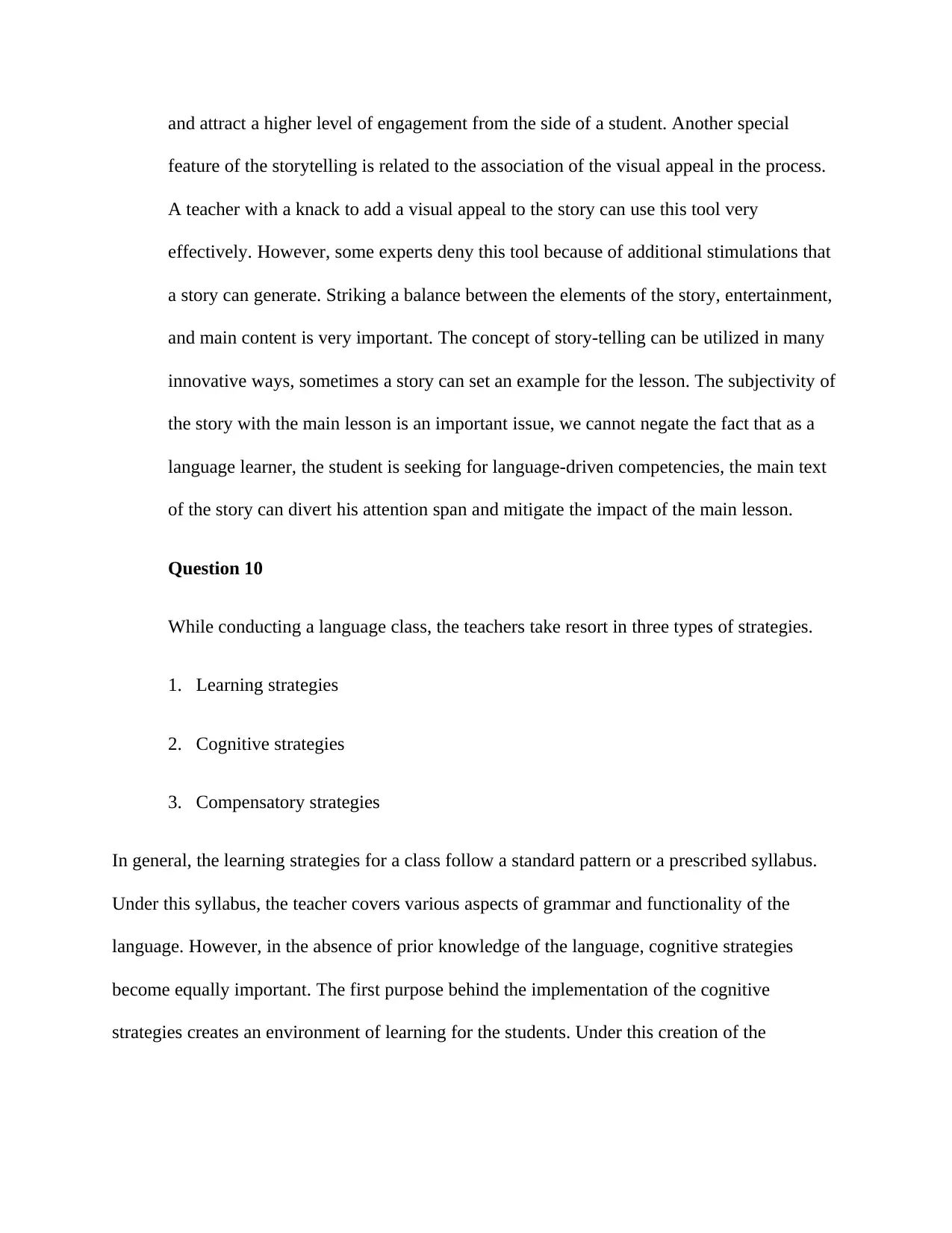
and attract a higher level of engagement from the side of a student. Another special
feature of the storytelling is related to the association of the visual appeal in the process.
A teacher with a knack to add a visual appeal to the story can use this tool very
effectively. However, some experts deny this tool because of additional stimulations that
a story can generate. Striking a balance between the elements of the story, entertainment,
and main content is very important. The concept of story-telling can be utilized in many
innovative ways, sometimes a story can set an example for the lesson. The subjectivity of
the story with the main lesson is an important issue, we cannot negate the fact that as a
language learner, the student is seeking for language-driven competencies, the main text
of the story can divert his attention span and mitigate the impact of the main lesson.
Question 10
While conducting a language class, the teachers take resort in three types of strategies.
1. Learning strategies
2. Cognitive strategies
3. Compensatory strategies
In general, the learning strategies for a class follow a standard pattern or a prescribed syllabus.
Under this syllabus, the teacher covers various aspects of grammar and functionality of the
language. However, in the absence of prior knowledge of the language, cognitive strategies
become equally important. The first purpose behind the implementation of the cognitive
strategies creates an environment of learning for the students. Under this creation of the
feature of the storytelling is related to the association of the visual appeal in the process.
A teacher with a knack to add a visual appeal to the story can use this tool very
effectively. However, some experts deny this tool because of additional stimulations that
a story can generate. Striking a balance between the elements of the story, entertainment,
and main content is very important. The concept of story-telling can be utilized in many
innovative ways, sometimes a story can set an example for the lesson. The subjectivity of
the story with the main lesson is an important issue, we cannot negate the fact that as a
language learner, the student is seeking for language-driven competencies, the main text
of the story can divert his attention span and mitigate the impact of the main lesson.
Question 10
While conducting a language class, the teachers take resort in three types of strategies.
1. Learning strategies
2. Cognitive strategies
3. Compensatory strategies
In general, the learning strategies for a class follow a standard pattern or a prescribed syllabus.
Under this syllabus, the teacher covers various aspects of grammar and functionality of the
language. However, in the absence of prior knowledge of the language, cognitive strategies
become equally important. The first purpose behind the implementation of the cognitive
strategies creates an environment of learning for the students. Under this creation of the
⊘ This is a preview!⊘
Do you want full access?
Subscribe today to unlock all pages.

Trusted by 1+ million students worldwide

environment, a teacher ensures that all the students are comfortable with their fellow students
and they are not feeling aloof because they belong to an alien culture.
After the successful implementation of the cognitive strategies a teacher monitors the growth of
each student and tries to figure out the gaps in the learning. This can become a difficult part
because language corresponds with the culture and a gap in the understating of the culture cannot
be filled with the help of subjective lessons. The onset of globalization forced many
multinational companies to conduct special language orientation classes for their employees.
Under these classes, the teachers define the knowledge with the help of the "compare and
contrast" method. Under this compare and contrast method, they compare the similar and
dissimilar points between L1 and L2 cultures. This exercise helps the learners in adopting the
right attitude towards the right application of the language. The same technique can be utilized in
the classrooms where a student can identify the application area of the language which is useful
for him or her, in the case language classes, teachers mostly utilize "exchange of pleasantries" as
one such area.
Question 11
1. In my views SLA theories are still in practice in the classrooms, many teachers are
utilizing them as a tool to enhance the environment of the class. The role of interaction in
the process of the acquisition of L2 knowledge is undisputed. Interaction allows a person
to practice his newly gained skills and correct them inside the classroom itself. It speeds
up the process of learning and helps a teacher in monitoring the performance of the
student. The process of interaction also connects the natural faculty of communication
with language learning quite effortlessly.
and they are not feeling aloof because they belong to an alien culture.
After the successful implementation of the cognitive strategies a teacher monitors the growth of
each student and tries to figure out the gaps in the learning. This can become a difficult part
because language corresponds with the culture and a gap in the understating of the culture cannot
be filled with the help of subjective lessons. The onset of globalization forced many
multinational companies to conduct special language orientation classes for their employees.
Under these classes, the teachers define the knowledge with the help of the "compare and
contrast" method. Under this compare and contrast method, they compare the similar and
dissimilar points between L1 and L2 cultures. This exercise helps the learners in adopting the
right attitude towards the right application of the language. The same technique can be utilized in
the classrooms where a student can identify the application area of the language which is useful
for him or her, in the case language classes, teachers mostly utilize "exchange of pleasantries" as
one such area.
Question 11
1. In my views SLA theories are still in practice in the classrooms, many teachers are
utilizing them as a tool to enhance the environment of the class. The role of interaction in
the process of the acquisition of L2 knowledge is undisputed. Interaction allows a person
to practice his newly gained skills and correct them inside the classroom itself. It speeds
up the process of learning and helps a teacher in monitoring the performance of the
student. The process of interaction also connects the natural faculty of communication
with language learning quite effortlessly.
Paraphrase This Document
Need a fresh take? Get an instant paraphrase of this document with our AI Paraphraser
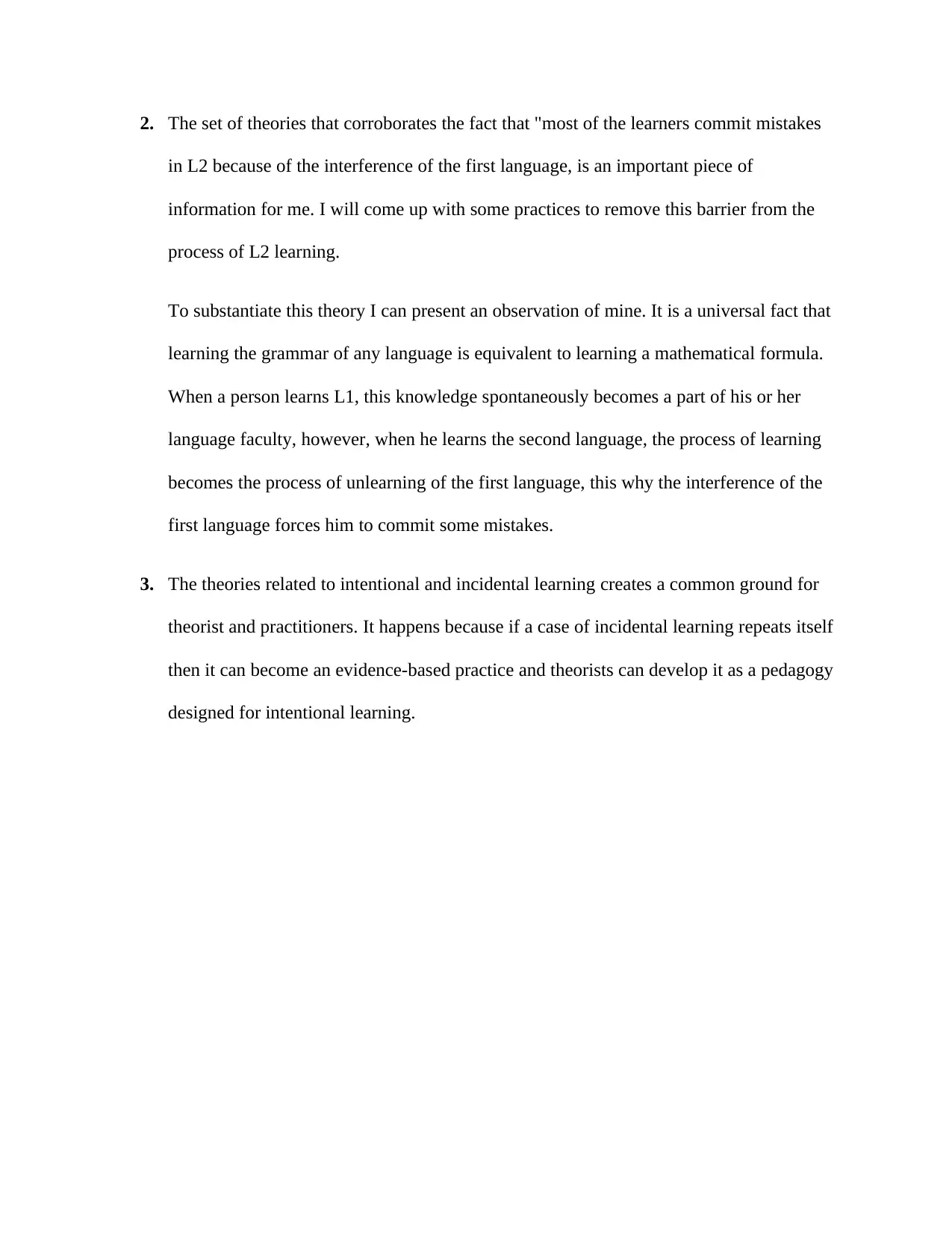
2. The set of theories that corroborates the fact that "most of the learners commit mistakes
in L2 because of the interference of the first language, is an important piece of
information for me. I will come up with some practices to remove this barrier from the
process of L2 learning.
To substantiate this theory I can present an observation of mine. It is a universal fact that
learning the grammar of any language is equivalent to learning a mathematical formula.
When a person learns L1, this knowledge spontaneously becomes a part of his or her
language faculty, however, when he learns the second language, the process of learning
becomes the process of unlearning of the first language, this why the interference of the
first language forces him to commit some mistakes.
3. The theories related to intentional and incidental learning creates a common ground for
theorist and practitioners. It happens because if a case of incidental learning repeats itself
then it can become an evidence-based practice and theorists can develop it as a pedagogy
designed for intentional learning.
in L2 because of the interference of the first language, is an important piece of
information for me. I will come up with some practices to remove this barrier from the
process of L2 learning.
To substantiate this theory I can present an observation of mine. It is a universal fact that
learning the grammar of any language is equivalent to learning a mathematical formula.
When a person learns L1, this knowledge spontaneously becomes a part of his or her
language faculty, however, when he learns the second language, the process of learning
becomes the process of unlearning of the first language, this why the interference of the
first language forces him to commit some mistakes.
3. The theories related to intentional and incidental learning creates a common ground for
theorist and practitioners. It happens because if a case of incidental learning repeats itself
then it can become an evidence-based practice and theorists can develop it as a pedagogy
designed for intentional learning.
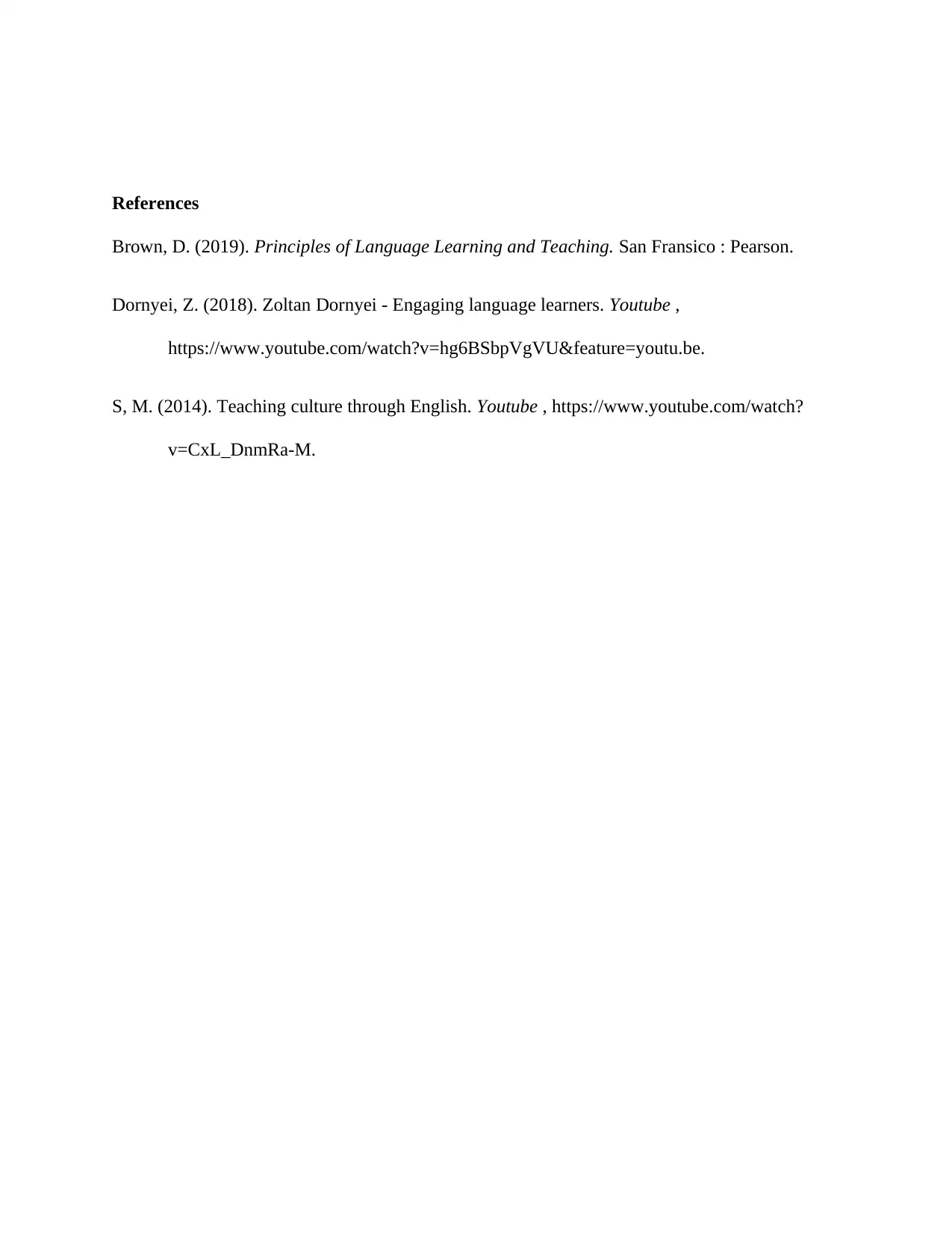
References
Brown, D. (2019). Principles of Language Learning and Teaching. San Fransico : Pearson.
Dornyei, Z. (2018). Zoltan Dornyei - Engaging language learners. Youtube ,
https://www.youtube.com/watch?v=hg6BSbpVgVU&feature=youtu.be.
S, M. (2014). Teaching culture through English. Youtube , https://www.youtube.com/watch?
v=CxL_DnmRa-M.
Brown, D. (2019). Principles of Language Learning and Teaching. San Fransico : Pearson.
Dornyei, Z. (2018). Zoltan Dornyei - Engaging language learners. Youtube ,
https://www.youtube.com/watch?v=hg6BSbpVgVU&feature=youtu.be.
S, M. (2014). Teaching culture through English. Youtube , https://www.youtube.com/watch?
v=CxL_DnmRa-M.
⊘ This is a preview!⊘
Do you want full access?
Subscribe today to unlock all pages.

Trusted by 1+ million students worldwide
1 out of 12
Related Documents
Your All-in-One AI-Powered Toolkit for Academic Success.
+13062052269
info@desklib.com
Available 24*7 on WhatsApp / Email
![[object Object]](/_next/static/media/star-bottom.7253800d.svg)
Unlock your academic potential
Copyright © 2020–2025 A2Z Services. All Rights Reserved. Developed and managed by ZUCOL.





